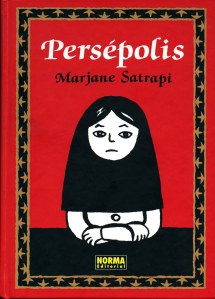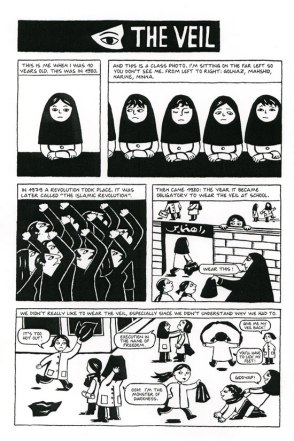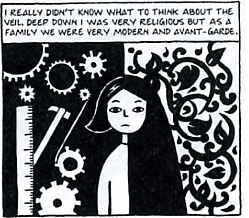In honor of Banned Books Week, my buddy Eric over at The Other Comic Book Teacher and I are going to review comics and graphic novels that have been challenged. Thanks to the Comic Book Legal Defense Fund for the handy dandy list. While you’re at it, go help the good folks over at CBLDF if you can. Their work helps keep comics on bookshelves. Also, check out the people over at The Uprise Books Project and their efforts to end poverty through literacy.

Today’s review is for Persepolis by Marjane Satrapi.
Why was it banned/challenged:? From CBLDF:
The circumstances surrounding the ban remain unclear to this day. In an email to employees, principal Christopher Dignam of Lane Tech College Prep High School initially said that he had been instructed by district administrators to remove Persepolis from the school’s library in addition to discontinuing its use in classrooms. Predictably, a furor ensued as students and teachers held protests and anti-censorship groups including CBLDF demanded an explanation. The day after Dignam’s email, district CEO Barbara Byrd-Bennett sent another email to principals claiming that the intention was never to remove the book from libraries, but only from classrooms due to “graphic language and images that are not appropriate for general use.”
Persepolis is a memoir of a girl’s childhood during the Islamic Revolution, and the culture shock that ensued from the fallout. See, this is what I hate about loglines and summaries: it just seems so…simple. Or maybe words are just failing me now. When we talk about important books it is always best to let the book do the talking, because they are the expert on themselves, and let’s face it, this book can certainly speak for itself.
So what do I say? Persepolis feels like I’m finally having a conversation with someone who be honest and open about her experiences. If you listen to young Marji you will hear her fears, her vulnerability, her independence, her righteousness, her feminism, and her revolution. For many of us, this might be the most meaningful interaction we have with someone from the Middle East, and isn’t that the point? Isn’t that why we share stories in the first place? Persepolis tells a universal story very specifically, and it’s in the specifics where this book really shines.
The structure, broken into sections of emotional and political benchmarks, gives the book an episodic feel which makes the heavy subject matter more digestable. What really makes this book a standout, though, is the juxtaposition of Satrapi’s simple, symbolic art with themes that even the most literate pieces of traditional literature can’t touch. By the time she is fourteen at the end of the book, we’ve seen Marji grapple with the meaning of freedom and its cost, the loss of faith, and the cruelty of death. This, I think, is what makes this an important book to use in classrooms. It gives students the opportunity to take a real look at something that they’ve only ever experienced through news clippings and the remote camera of a Tomahawk missile. Students get to see that there are real people on the other side of those headlines, and maybe there are kids just like them.

Good For Ages: 14 and up. I won’t sugar coat it here: revolution is not pretty. There are scenes of violence in this book, but I would submit that this violence is no more terrible than what students see in living color in their history classes.
Classroom Rating: 10/10. There is so much to unpack when teaching this book. I think it belongs in the canon, and it should be adopted as a part of your curriculum yesterday.
What Could You Teach With Persepolis?: This is one of the rare opportunities for cross-curricular teaching. Not only would this make for a killer lesson on the history of Iran (the book is named after the ancient Persian capital city), but it lends itself well to discussing current events. This book gives teachers a built in way to have their kids make connections between two subjects, and it also allows for scaffolding between the two disciplines. Heck, there’s even a religious aspect if you have a World Religions course at your school.
Highlights: The knack for delivering complex history and concepts from a child’s perspective is the best part of this book. I really enjoyed Marji wrestling with the contradiction between her liberal home life and her conservative public life. Yet another classic.
What do you think? Leave a comment or continue the convo on Twitter:@misterwhitaker and follow my partner @comics_teacher too!

Rather than ban Persepolis or Persepolis 2, any school administrator or teacher who is responsible for banning these excellent graphic novels should be banned from ever working in a school again.
LikeLike